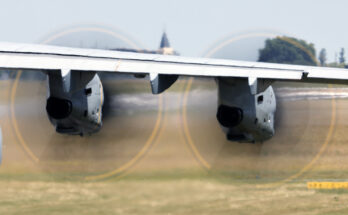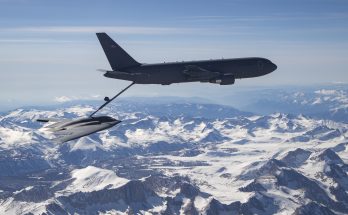
The recent collision between a U.S.-operated MQ-9 Reaper unmanned air vehicle (UAV) and a Russian Air Force Su-27 Flanker fighter over the Black Sea has once again perked interest in this unmanned surveillance system. Here is everything you need to know about the MQ-9 Reaper.
Contractor: General Atomics
The Reaper is the new name given to Predator Bs operated by the U.S. Air Force. The MQ-9 Reaper is a medium- to high-altitude, long-endurance UAS that acts as a persistent hunter-killer for critical time-sensitive targets, and as an intelligence collection asset.
The integrated sensor suite includes an SAR/MTI (DAS-1) capability (including the APY-8 Lynx II radar) and a turret containing electro-optical and midwave IR sensors, a laser rangefinder, and a laser target designator (the Raytheon Multispectral Targeting System-B, or MTS-B). An entire system consists of four air vehicles, a ground control station, and a satellite communications suite. The crew is made up of one pilot and one sensor operator.
The Reaper uses a Honeywell TPE331-10Y engine, but the Pentagon plans to add a second source.
By the end of 2006, the USAF had taken delivery of 10 MQ-9 Reaper air vehicles, all preproduction versions. The first production air vehicle arrived in early 2007.
In 2007, the Air Force decided to provide 16 Reapers to its Special Operations Command (AFSOC). These air vehicles were part of the FY07 and FY08 defense budgets.
On November 9, 2006, the Air Force activated the first Reaper Squadron (42nd Attack Squadron), at Creech Air Force Base, just north of Las Vegas, with the first MQ-9 aircraft arriving March 13, 2007. The first missile firing by a U.S.-operated Reaper UAV took place on October 27, 2007.
| Reaper – Technical Data | |
| Length | 10.98 m |
| Wingspan | 20.13 m |
| Weight, gross | 4,767 kg |
| Weight, fuel | 1,816 kg |
| Weight, payload external | 1,362 kg |
| Weight, payload internal | 340.5 kg |
| Speed, cruise | 120 kt |
| Speed, max | 230 kt |
| Altitude | 50,000 ft |
| Radius | 3,065 km |
| Endurance | 24 hr |
| Endurance, external stores | 4-20 hr |
By February 2016, the U.S. Air Force had 177 Reaper UAVs operational (167 Block 1 and 10 Block 5 air vehicles). The first export customer for Reaper is the United Kingdom, which purchased three Reaper UAVs and two ground control stations under an urgent operational requirement in 2006.
France also ordered the Reaper UAV.
The Air Force is working to extend the range of the Reaper UAV to 42 hours. The air vehicle will receive extra fuel capacity. General Atomics received a $117 million contract in 2014 to build 38 extended-range versions of Reaper. This is the MQ-9 Accelerated Extended Range model. The U.S. could retrofit 98 air vehicles with this capability. The Pentagon could decide to forgo upgrading existing systems and instead purchase all-new air vehicles.
The first flight of the Reaper ER version in Afghanistan took place on December 1, 2015. This version is also known as the Predator B Big Wing.
General Atomics performed the first flight of the Reaper ER Long Wing on February 18, 2016. This air vehicle features improved long-endurance wings with greater internal fuel capacity and additional hardpoints for carrying external stores. The air vehicle has a 79-foot wingspan.
The U.S. Air Force had delivered 44 modified Block 1 ER air vehicles by July 2016. The Pentagon could modify 165 Block 1 and 136 Block 5 air vehicles.
In addition, General Atomics revealed in 2022 that work had started on a short takeoff and landing (STOL) version of the MQ-9B SeaGuardian UAV. The MQ-9B STOL configuration will consist of an optional wing and tail kit that can be installed in less than a day, according to the company. The core air vehicle and its subsystems remain the same.
The MQ-9B STOL air vehicle will have a 50 percent drop in endurance when carrying a payload equal to that of the standard MQ-9B version. The STOL version has been able to launch and recover in less than 91.4 meters during tests. The STOL version also has foldable wings and can be launched without catapults.
Customers: The U.S. is the largest operator of the Reaper UAV. Foreign customers for the Predator/Reaper family of UAVs include Italy, the United Kingdom, The Netherlands, Morocco, the United Arab Emirates, Spain, France, Belgium, and Japan.
Forecast International’s Unmanned Vehicles Forecast – Airborne Systems provides worldwide coverage of airborne unmanned vehicles, from the globe-trotting Global Hawk to the deadly Reaper, and covers the individual markets for reconnaissance UAVs and aerial targets. It also includes a section on the use of UAVs for civilian applications, ranging from environmental cleanup and forest monitoring to agricultural activity such as crop spraying and crop monitoring. Production will increase substantially over the next 10 years, with commercial systems expected to account for the lion’s share. An annual subscription includes approximately 70 individual reports, most with a 10-year unit production forecast. For more information, click here.
For 50 years, Forecast International intelligence reports have been the aerospace and defense industry standard for accurate research, analysis, and projections. Our experienced analysts compile, evaluate, and present accurate data for decision makers. FI's market research reports offer concise analysis of individual programs and identify market opportunities. Each report includes a program overview, detailed statistics, recent developments and a competitive analysis, culminating in production forecasts spanning 10 or 15 years. Let our market intelligence reports be a key part of reducing uncertainties and mastering your specific market and its growth potential. Find out more at www.forecastinternational.com



